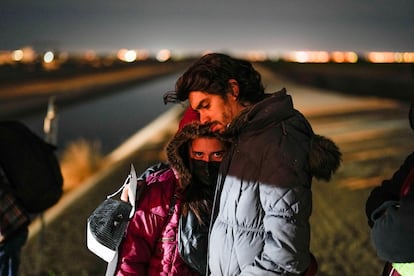From a population of 11 million to little more than 8.5 million: The real toll of Cuba’s migratory crisis
According to numbers compiled by Cuban economist and demographer Juan Carlos Albizu-Campos, the island’s population fell by 18% between 2022 and 2023

The streets in Cuba look empty. Dozens of residents in every neighborhood have shut the door to their homes for the last time. Long lines in the Havana airport to board a flight to Nicaragua grow by the day. Some time ago, there was talk of a stampede, a collective fever to escape, to avoid being the last witness of a country’s collapse. Nearly three years ago, it was said that Cuba was seeing the biggest migratory wave in its history, and though authorities have not released official data regarding the current population, a new study reveals the real toll of the island’s dramatic exodus.
“I have never seen so many people emigrating as I am right now,” says 43-year-old Havana resident Valia Rodríguez. “Of course, any Cuban would love to go. I would, for example. If I had the means, I would go, because in this country, with this government, one can’t live. And I’ll tell you something else, if I hadn’t recently given birth, I would have left, because the situation is unsustainable.”
Although it’s clear that emigration in Cuba has taken off since 2021, official reports and government data describe a current population of just over 11 million who still live in the country. But that number is a figure from the past. Cuban economist and demographer Juan Carlos Albizu-Campos has announced that between 2022 and 2023, the island’s population fell by 18%, meaning that in reality, there are 8.62 million Cubans living there today.
In an interview with EL PAÍS, Albizu-Campos, a researcher from the Christian Center of Reflection and Dialogue who worked for 30 years at the Center for Demographic Studies and later, at the Center for Studies of the Cuban Economy, said that, given the lack of up-to-date official numbers, he used the electoral roll from the February 13, 2013 elections, which registers people aged 16 and over, and is based on the last census conducted in the country in 2012. The demographer explained that, although censuses are normally carried out every 10 years, the next one will not take place on the island until 2025 due to the current crisis, a similar delay to that which took place during Cuba’s Special Period following the fall of the Soviet Union, which caused the census to be held after 20 years, in 2012. To count the members of the population who are zero to 15 years old, the researcher used data from Cuba’s Anuario Estadístico (Statistical Yearbook).
Albizu-Campos places the beginning of today’s exodus at the beginning of October 2021, a peak of the current migratory wave, when the number of Cubans reported at the U.S.-Mexico border multiplied. His study also references the 738,680 Cubans who arrived in the United States between October 2021 and April 2024 after receiving immigrant visas, according to figures from U.S. Customs and Border Protection (CBP). “That doesn’t mean that before, people weren’t leaving,” says Albizu-Campos. “But, beginning in October 2021, the numbers start to be very large in relation to what was happening.”
Between 2021 and now, the Cuban migratory exodus has far exceeded previous mass departures, such as El Mariel in 1980 (125,000), the Balseros Crisis in 1994 (34,500) and Boca de Camarioca in 1965 (about 5,000). What happened in 2021 to convince thousands of Cubans to start leaving their country en masse? An accumulation of chaos and bad decisions. The economy had been moving towards collapse since 2019, there were the economic sanctions of the Trump administration, economic and political measures that sank the country even further, a pandemic that forced the closure of borders worldwide and directly affected Cuba’s fundamental industry, tourism, and the growing lack of medicine and collapse of the health system. In general, there was an environment of instability and political fracture that in 2021, led to the largest citizen protest that Cuban had seen since 1959. The situation accelerated many Cubans’ departure, suggesting that things would not be getting any better in the near future.
Emigration now seems to be the only source of hope to many Cubans, who are selling everything, right down to their houses, to be able to pay for a one-way ticket. Their decisions have added up to a migratory wave that, between 2022 and 2023 alone, according to Albizu-Campos, accounted for the departure of 1.79 million people from the country.
Confirmation of Cuba’s population decline has caused its fair share of reverberations. A few days after Albizu-Campos’ alarming data was published, the government announced that, though a new census would be necessary to know exact numbers, “the population of Cuba is currently less than 10 million inhabitants and will continue to decrease.” The Havana, Cienfuegos and Mayabeque provinces have seen the greatest losses in population, a phenomenon that, as is acknowledged by the government itself, will have repercussions on “plans, programs, projects in the demographic, economic, social and environmental fields.” If numbers continue to trend in the same direction — influenced by a variety of factors — Cuba’s population could fall below six million by the year 2100, according to projections from a recent UN report.

The many destinations of the Cuban emigrant
In 2013, under Raúl Castro, Cubans were not only once again allowed to stay in hotels and sell their privately-owned homes, but also saw the possibilities for going abroad expand. That year’s immigration reform annulled the so-called “white card” and “invitation letter,” meaning that Cubans could start to travel with just their passport and a visa approval from their destination country. “What is happening now is that Cuba is seeing migrants leave through a variety of doors. Before the 2013 immigration reform, emigration was very controlled. When those limitations were lifted, suddenly the population discovered that there were many exits,” says Albizu-Campos.
Since 2008, thousands of Cubans have left for Ecuador after Rafael Correa’s administration eliminated visa requirements for the island’s citizens. The South American country became the escape route for many, who would subsequently travel up Central America to the United States. Today, the migratory path starts in Nicaragua. A report from U.S. think tank Inter-American Dialogue found that on average, 50 charter flights departed from Havana to Managua every month between January and October 2023, transporting some 100,000 people who would later begin their journey north. The latest CBP figures put the number of Cubans who arrived in the United States legally in 2024 through June, via all border crossings, at 106,757. Three months away from the end of the fiscal year (which takes place in September), 180,925 Cubans have entered the United States using different routes, including visas, humanitarian parole or irregular arrivals via the southern border or by navigating the Florida Straits.
According to the UN, Cubans currently live in 140 countries around the world. The United States is at the top of this list, followed by Spain, Italy, Mexico and Canada. Albizu-Campus explains that, although the United States is the final destination in many cases, it’s very difficult to arrive there directly and that thousands of Cubans choose other countries as their primary destination. According to the Mexican Commission for Refugee Aid (COMAR), more than 8,800 Cubans applied for refuge in Mexico between January and June of this year. In 2023, some 4,000 Cubans applied for help from the government of Uruguay, according to the country’s Ministry of Social Development.
On its end, the Biden administration has taken a series of steps to slow irregular migration, widely granting humanitarian parole to Cubans beginning last year. But it has also imposed restrictive measures on the granting of asylum at the border and has collaborated with the Panamanian government to block crossings in the Darién Gap. But Cubans have continued to find ways out of their country’s current crisis.

So alarming is the situation that a few months ago, a Havana authority publicly recognized that the country is experiencing its largest exodus of all time. Deputy director general for the United States at the Cuban Foreign Ministry, Johana Tablada de la Torre, blamed Washington D.C. for the “unprecedented increase in the current migratory flow,” which she called “disproportionate” at a press conference. “It is, in essence, the largest migratory wave in Cuba’s history,” she said. In a recent interview with AP, First Colonel Mario Méndez Mayedo, head of the Directorate of Identification, Immigration and Foreigners’ Affairs, say that there are currently three million Cubans living in foreign countries.
Women, at the head of the Cuban exodus
But emigration is not the only worrisome indicator when it comes to Cuban demographics. Albizu-Campos warns that there also exists a “negative balance of natural growth” in a country where, in 2022 and 2023, there were more deaths than births. Even the National Office of Statistics and Information (ONEI) has recognized that an “accelerated demographic aging” is taking place among 22.3% of its total population, admitting that “since 1977, population replacement has not been achieved.” The demographer also says that, in addition to the migratory balance, there is a “downward trend” in the population due to “low fertility, the negative balance between birth and death rates.” The government estimates that in 2024, births will number less than 80,000, the lowest since 1959.
According to Albizu-Campos, a general downward trend of birth rates has been taking place on the island since 2019. “There is a combination of the birth rate slowing and the decreasing number of mothers who are giving birth,” he says. “The birth rate in Cuba is the result of a process called transition from fertility. There were changes to women’s status, above all after 1959, through which women became the hub of transformation and changes that began to take place,” he says.
Women are also migrating more. According to UN figures, 133 women leave the country for every 100 men, meaning that 56% of migrants are women. “There is a pattern that when emigration is irregular, men dominate. When you look at the 1994 Balseros crisis, that was mainly men. What is happening today is that Cuba is producing migrants who are leaving regularly through various exit points. This kind of migration is much safer for women and many mothers are leaving. Women of reproductive age leave, and that affects the number of births,” says Albizu-Campos.
The demographer emphasizes that, given that 77% of people who are emigrating are between 15 and 59 years old, “we’re seeing a pattern of grandparents left alone with children.” It’s a phenomenon called “Peter Pan in reverse,” as opposed to 1959′s so-called Operation Peter Pan, when 14,000 children arrived in the United States, sent by their parents under the promise of later reunion, indicative of their fear of what could take place in the wake of the Cuban Revolution. “Young parents tend to emigrate on their own, because they follow complex migratory paths,” Albizu-Campos says. “Before, people who wanted to emigrate sent their children ahead of them. Now it’s the opposite, people emigrate and leave their child behind.”
Sign up for our weekly newsletter to get more English-language news coverage from EL PAÍS USA Edition
Tu suscripción se está usando en otro dispositivo
¿Quieres añadir otro usuario a tu suscripción?
Si continúas leyendo en este dispositivo, no se podrá leer en el otro.
FlechaTu suscripción se está usando en otro dispositivo y solo puedes acceder a EL PAÍS desde un dispositivo a la vez.
Si quieres compartir tu cuenta, cambia tu suscripción a la modalidad Premium, así podrás añadir otro usuario. Cada uno accederá con su propia cuenta de email, lo que os permitirá personalizar vuestra experiencia en EL PAÍS.
¿Tienes una suscripción de empresa? Accede aquí para contratar más cuentas.
En el caso de no saber quién está usando tu cuenta, te recomendamos cambiar tu contraseña aquí.
Si decides continuar compartiendo tu cuenta, este mensaje se mostrará en tu dispositivo y en el de la otra persona que está usando tu cuenta de forma indefinida, afectando a tu experiencia de lectura. Puedes consultar aquí los términos y condiciones de la suscripción digital.
More information
Archived In
Últimas noticias
Maduro counterattacks Trump with rhetoric and announces downing of nine drug trafficking aircraft
‘Ecce Homo’: The miraculous disaster that made a small Spanish town famous
Return to sex testing at the Olympics: IOC edges closer to banning transgender women
Trump escalates conflict with Venezuela with the start of covert operations
Most viewed
- Sinaloa Cartel war is taking its toll on Los Chapitos
- Oona Chaplin: ‘I told James Cameron that I was living in a treehouse and starting a permaculture project with a friend’
- Reinhard Genzel, Nobel laureate in physics: ‘One-minute videos will never give you the truth’
- Why the price of coffee has skyrocketed: from Brazilian plantations to specialty coffee houses
- Silver prices are going crazy: This is what’s fueling the rally











































